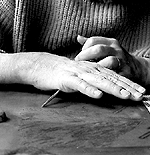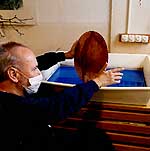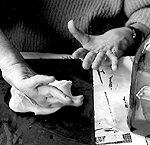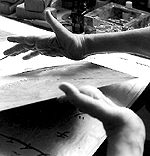|
 |
|
I lay the plate
in front of me and sense it slowly with my hands and eyes. Where I "hang up", I
linger, orient myself, seek connections to other places. With various tools, etching
needles, moulders, scrapers, hand drills and polishers, I deepen and clarify the traces
and expand them into a linear web. In this process, bundles, rays and hollows coalesce
into an image network. This process, without any etching, is called dry point. |
 |
|
Then the plate
is covered with vernis satiné (a kind of fine wax layer). In the dry paper-thin layer, I
draw with feathers and etching needles, I explore and complete the underlying network of
lines, which sometimes glimmers through, with strokes, points, scratches. |
 |
|
The plate is
placed in the acid bath where the lines and marks are bitten into the copper, this is
called etching. I work mostly with nitric acid, mixed as the old masters did it,
with salt or acetic acid added, depending on how fast I want to work and what effect I
want to achieve. |
 |
|
After the acid
bath, nothing can be erased or corrected. What is there on the plate, remains there. It
can be toned down or weakened using polishers, steel wool and charcoal, but not erased.
For the aquatint process, I dust the cleaned plate with asphalt powder or rosin. |
 |
|
So that the dust
layer doesn't fly away before the next etching bath, I apply heat under the plate. The
smaller grains of dust melt slightly and stick to the copper. After the next etching,
surfaces emerge whose depth is determined by how long they were in the acid bath. In
between etchings, I apply another coat of vernis noir to the various areas, thereby
achieving light, middle or dark tones in further printings. |
 |
|
Sugar lift,
vernis mou, and acid tints are further processes. Their flexibility offers many
opportunities for the artist to expand his visual vocabulary and find his own expression.
During all these processes, I can only see the copper plate. Now, just before the printing
process, the plate is cleaned. |
 |
|
Using
cheesecloth or tissue paper and last by hand in the process called wiping, the ink is
removed from the surface of the inked plate. What lies in the etched areas is what will
create the image: etching is an intaglio process. For my colour etchings, each colour has
its own plate. |
 |
|
On the printing
press bed, the inked copper plate lies ready. The moistened paper is laid over it and
turned slowly through the large wheel of the printing press. The heavy rollers slowly
press the paper onto the etched plate. The moist Bütten paper absorbs the color from the
depths of the points, lines and areas - an etching comes into being. |
Copyright © 1999, Walter Ehrismann
Visit Walter Ehrismann's web site to view more of his work.
You may contact him at admin@ehrismann.com.
[ Artist Interviews | Artshow.com ] |
|

